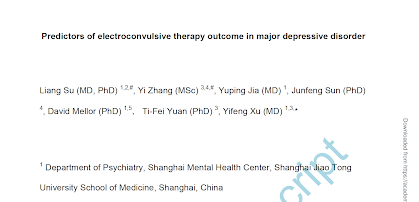Predictors of ECT Outcome: New Data Analysis From China
Out on PubMed, from investigators in China, is this paper:
Predictors of electroconvulsive therapy outcome in major depressive disorder.
Int J Neuropsychopharmacol. 2022 Oct 3:pyac070. doi: 10.1093/ijnp/pyac070. Online ahead of print.PMID: 36190694

Background: Electroconvulsive therapy (ECT) is an effective therapy for Major Depressive Disorder (MDD) patients. However, few clinical predictors are available to predict the treatment outcome. This study aimed to characterize the response trajectories of MDD patients undergoing ECT treatment and to identify potential clinical and demographic predictors for clinical improvement.
Methods: We performed a secondary analysis on data from a multicenter randomized, blinded, controlled trial with three ECT modalities (bifrontal, bitemporal, unilateral). The sample consisted of 239 patients whose demographic and clinical characteristics were investigated as predictors of ECT outcomes.
Results: The results of Growth Mixture Modeling (GMM) suggested that there were three groups of MDD patients, a non-remit group (N=17, 7.11%), a slow response group (N=182, 76.15%), and a rapid response group (N=40, 16.74%). Significant differences in age, education years, treatment protocol, types of medication used, Hamilton Depression Scale (HAMD), Hamilton Anxiety Scale (HAMA) score, Mini-mental State Examination (MMSE) score, and Clinical Global Impression (CGI) score at baseline were observed across the groups.
Conclusions: MDD patients exhibited distinct and clinically relevant response trajectories to ECT. The MDD patients with more severe depression at baseline are associated with a rapid response trajectory. In contrast, MDD patients with severe symptoms and older age are related to a less response trajectory. These clinical predictors may help guide treatment selection.
Keywords: Growth Mixture Model; Logistic regression; Major Depressive disorder; electroconvulsive therapy.
The article is here.
And from the text:
The rest of the paper I find confusing (subjects from a prior study plus unpublished data?, effect of age?), and more concerned with fancy statistical methods than anything else. Call me a Luddite (again), but if you see it differently, I would love for you to submit a comment, thanks.





Comments
Post a Comment